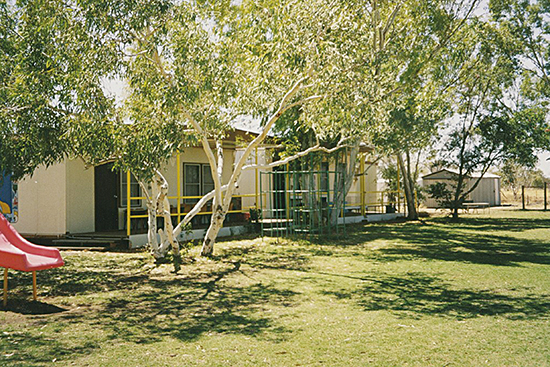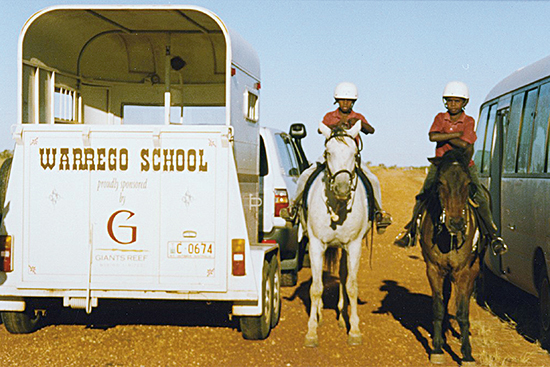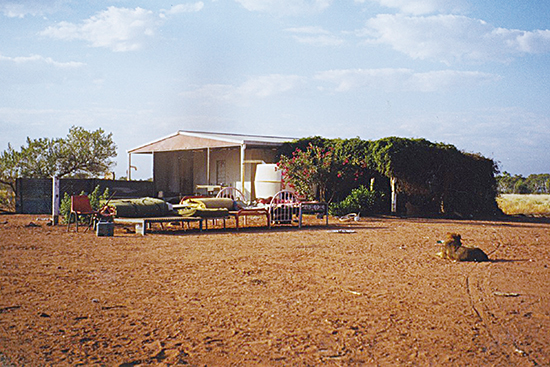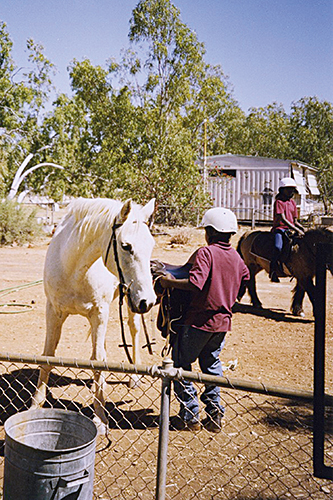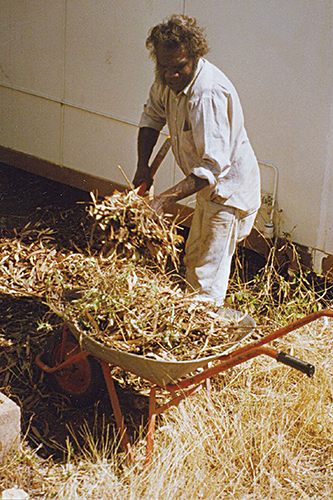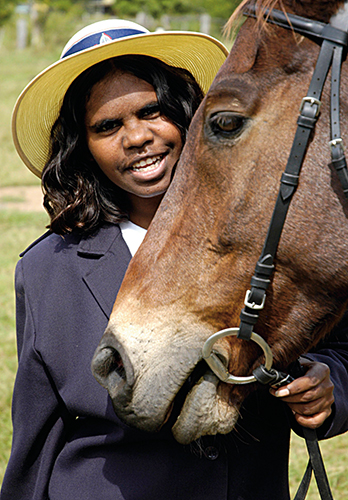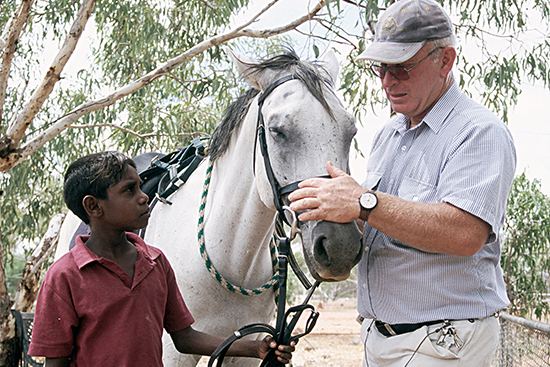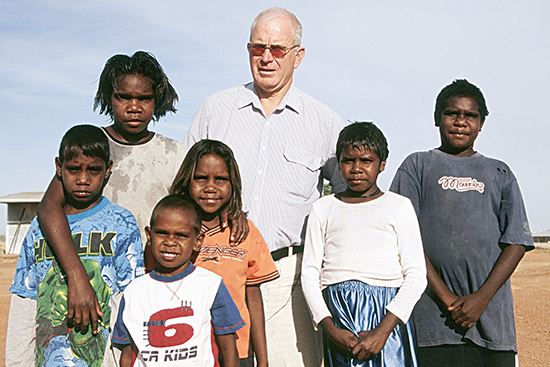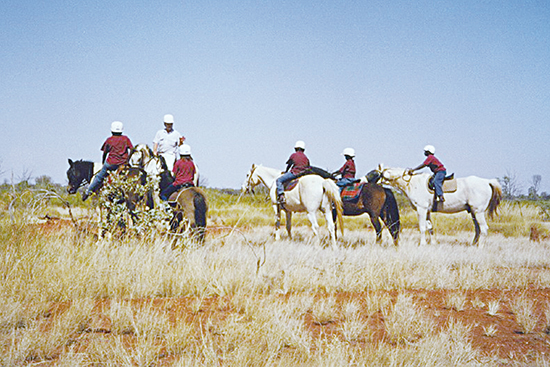 A little while back, an email appeared in my inbox from a visiting Canadian veterinary professor, John Baird, calling my attention to an SBS television documentary, “Bush School” (Australia Storylines series).
A little while back, an email appeared in my inbox from a visiting Canadian veterinary professor, John Baird, calling my attention to an SBS television documentary, “Bush School” (Australia Storylines series).
“As people strongly involved in the horse industry and having been involved for many years with pony club in Canada, both my wife and I thought this was the most inspirational story we have seen for many years on TV anywhere! You have to see the show to appreciate what an amazing job the Bakers in conjunction with the tribal elders are doing. Essentially Colin Baker was asked to teach the kids how to ride because the chief elder wanted stockmen for the future and as a spin-off the school attendance is 100%. He has taught them to swim well and compete in swimming carnivals, their numeracy and literacy is simply amazing, I could go on and on…”
We asked Suzy Jarratt to chase down the story and bring to the readers of The Horse. We find the story inspirational, and hope you do too!
Several weeks ago SBS TV screened a documentary about teachers Colin and Sandra Baker and a small, indigenous school on the edge of the Tanami Desert threatened with closure. Viewers applauded the innovative attitude of the Bakers and the achievements of the students at Warrego School considered by many to be children without a future. This school now boasts 100% attendance and the story not only inspired visiting Canadian academics; the praise from viewers was swift:
“You two have done an incredible job. I admire your patience, persistence and ability to think outside the square.”
“I can’t commend you enough for your dedication towards ensuring these fantastic children make a future for themselves.”
“I am a teacher and I thought I could sell my house to buy you a bus. What you’re doing is so important and I’m so impressed by the integration of programs to cover everything in a way that’s meaningful and enjoyable to the children.”
‘It’s inspiring to see an educational program that’s paying attention to needs from the bottom up rather than ineffective, bureaucratic top down approaches.”
In 1999/2000 when the mining town of Warrego closed and the families moved on, the school’s principal, Colin Baker, was told that the school could continue if he could persuade the children from the Mungalawurru community to regularly attend school. The Mungalawurru students, 36 kms away, were rarely seen in school – attendance was less than 10% a year. A program needed to be developed that would meet both the education needs and the expectations of the community and simultaneously be interesting for students.
Colin Freddie, a senior traditional owner and tribal elder, saw Colin Baker riding out on his Arab, Sadu, and asked him if he could ‘teach the kids to ride’. He added ‘we want to run the cattle – we used to be stockmen, now we’re nothing’. Colin agreed on the understanding the students attended school every day. During term 4 of 1999, Colin Freddie drove the children to Warrego and stayed to help with the equestrian program. The next year the Education Department supplied the school with a Troupe Carrier resulting in the Bakers doing a 144 km school bus run each day.
The children at Mungalawurru all live with carers who are either their great-grandmothers, grandmothers, great aunts or aunts – the oldest carer being 84 years-old.
Although this is a ‘dry’ camp all the carers except Eva Kelly (lovingly known as ‘the old lady’) suffer from the long term effects of their pre1·ious alcoholism. The students were sent to Mungalawurru from camps in Tennant Creek and further afield to escape alcohol and violence. These students come from very disturbed backgrounds and have experienced all kinds of abuse and neglect. In partnership with the Mungalawurru community the teachers developed two special programs in horsemanship and swimming. The children desperately needed to increase their self-confidence, self-esteem and their use of the English language, so that normal academic activities could be undertaken. As well as developing life skills the programs were aimed at increasing the use of English by giving it a practical application – the only time these students use English is at school, in camp they speak either Warramunga or Warlpiri and ‘Aboriginal’ English when in town.
It was decided the horsemanship program would not be used as a reward, instead it was to be the centre of the children’s education. As the students gained an understanding of the importance of caring for their horse’s health and fitness they began to fully understand how important it was to live and maintain a healthy lifestyle. Once their health and fitness improved they began to understand that through riding and learning other aspects of horsemanship there was a future for them and that they would have skills to support and further develop interesting pathways for themselves.
They began the program with Sadu but needed at least another horse. The Arabian was too big and strong for many of the children who ranged from 5 to 13. They commissioned the family pony Hakie – a 20-year-old Arab Welsh Mountain cross. He suited the job perfectly.
All students began by riding bareback before advancing to a saddle. They learned how to water, feed and groom, maintain tack and care for their own riding clothes and safety equipment.
As attendance levels improved more horses were needed. With financial help from
The Trust for Young Australians they acquired a grey pony (a miniature version of Sadu) and after becoming involved in the Tennant Creek Pony Club and becoming more competitive they purchased Siker, another grey with black points.
This program has given several students skills to confidently step outside the norm and go to boarding school. One of the girls has successfully completed almost three years at NEGS – her riding skills allowed her to compete as an equal with the other girls – another student is in her first year at Melbourne Girls Grammar and in 2007 two boys will leave the remote community to attend a boarding school in Bathurst.
The school’s swimming program goes hand in hand with horsemanship. Through competitive swimming the students have gained a better understanding of the benefit of a good diet to underpin their improved health which in turn gives them strength and confidence to successfully compete in Northern Territory club carnivals.
The comprehensive health program, put in place by Sandra Baker, resulted in several health issues being identified. With the exception of one child all have hearing problems ranging from slight to severe and several have sight defects. The program includes showering each morning, first aid and medication, if necessary, and monthly checks by the Aboriginal Health Team.
Some of the problems included a child who had been expelled from other schools for violence. Medical investigations revealed he had an underdeveloped respiratory system which did not allow sufficient oxygen to the brain, causing chemical changes resulting in fits. Sandra taught him to manage his condition without medication. Another student was an elective mute very frightened and aggressive. Investigations showed he had severe hearing problems. For six weeks he lived with the Bakers while undergoing oral and topical treatment. He has become a competent horseman with a future.
In recent years at the request of their carers, students have undertaken excursions which have given them an insight into the many and varied employment opportunities available, and the reason they need an education. Each trip has included four days of professional horsemanship coaching. And each year the students march on ANZAC day. One of the school’s horses leads the parade in WWI light horse tack led by a student also dressed as a light horseman.
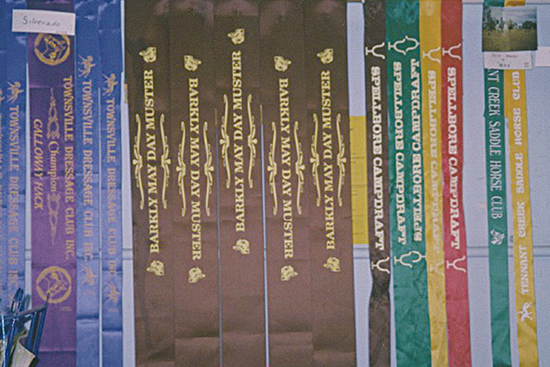 Undoubtedly this school is successful because of the Bakers and their philosophy to ‘lead from the front’. They believe in innovative and appropriate programs that will achieve the aims of the school and the aspirations of the community and the students.
Undoubtedly this school is successful because of the Bakers and their philosophy to ‘lead from the front’. They believe in innovative and appropriate programs that will achieve the aims of the school and the aspirations of the community and the students.
The Mungalawurra community’s cattle project is now up and running and in 2007 Warrego School will undertake to rear two calves and teach the children about this aspect of animal husbandry.
Inevitably words like visionary, inspirational and dedicated are used to describe Colin and Sandra Baker – but let us not forget, practical and hardworking. Several years ago, these two teachers, the grandparents of twins, worked tirelessly with tribal elders to develop something which had never been done before- create incentives which would encourage the outback children in the region to go to school. And this is not a school where the kids start at nine, finish at three and the lollipop man helps them to cross the road. The Mungalawurra community is many kilometres away. The Troupe Carrier can only take so many pupils and while spiralling enrolments are welcomed it means school is split into two sessions – beginning at 7.30 am, finishing at 6pm. Another vehicle would be so useful!
No longer are the children destined to be left to wither in isolation- the Bakers have provided them with a place in which they are happy to develop, interact and learn not only the three Rs, but about competition swimming, animals, nutrition and horsemanship. But as readers are aware it costs quite a few thousand dollars a year to look after a horse, and saddlery, boots and clothing are always needing to be replaced – any assistance would be appreciated.
The younger children will continue with the horsemanship program while older students will also learn cattle skills.
Sandra Baker stated that these programs are not covered by government recurrent funding so all related costs must be covered by fundraising through sponsorship and donations.
“Our biggest ongoing costs,” she said, “are for riding boots, helmets, jeans and horse feed.”
– Suzy Jarratt
If it hadn’t been for filmmaker Bryan Duffy few would have known about Warrego. Duffy, who is Sandra Baker’s brother, took several years to make this documentary. And like his sister and brother-in-law he made sacrifices in order to complete the project.
Copies of the documentary can be purchased from: www.marcom.com.au
The Equestrian Response
We thought we’d ask a few of our friends in the equestrian industry if they could help out – and this was the response:
MITAVITE: 20 bags of feed
HORSELAND: 10 pairs of riding boots
NATURE VET: 12 Ammo Wormers and 6 packs of Vam Chewables
BATES: A fully mounted Wintec 500 All-Purpose Saddle

